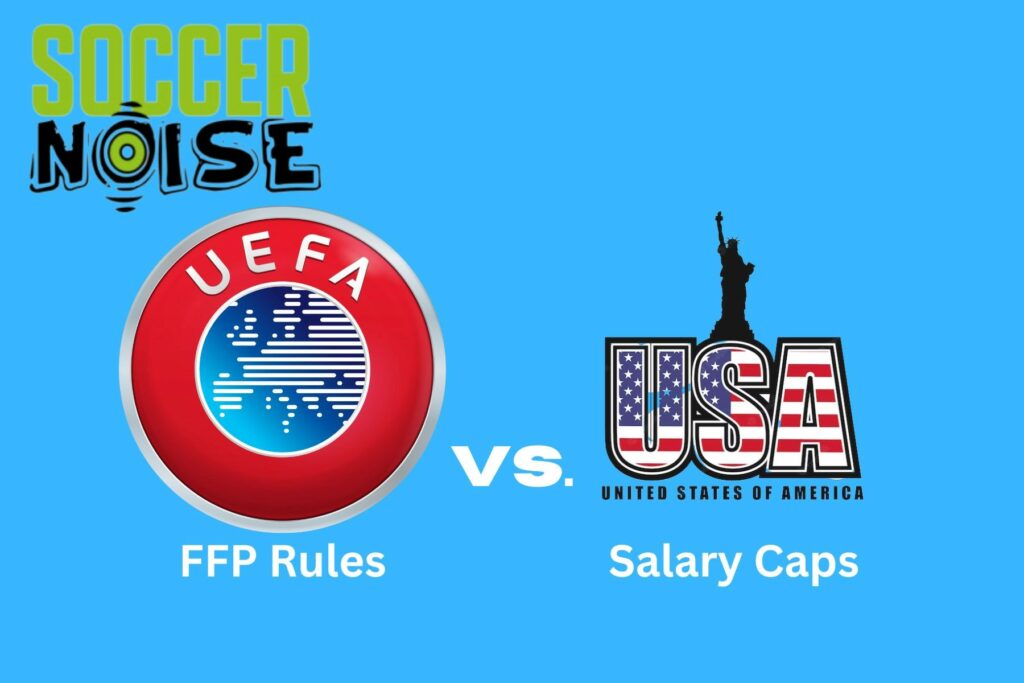If, like me, you closely follow both European Football and North American Sports like the NBA and NFL, then you will be familiar with salary caps and the increasing importance of Financial Fair Play rules. In this article we look to explore the similarities and differences between the two approaches.
Is Financial Fair Play in Soccer like a Salary Cap? Both Salary Caps in North American sports, such as the NFL and NBA aim to ensure prosperity for the teams and league as a whole by limiting spending. However they differ in their mechanism of doing this. In simple terms Salary Caps aim to limit the amount of spending a team can make on their player salaries, aiming to create parity amongst teams, in contrast the FFP rules of European Football look to limit spending to within a clubs own means with the main goal of creating sustainability, creating parity is not a concern. In theory under a salary cap, rich teams and poor teams can compete on a more even footing, in European Soccer rich teams are still allowed to significantly outspend their rivals, as long it’s done with money the club itself can generate.

If you are unfamiliar with the basics of how FFP works in European Football, have a read of our summary article here. If you have no idea how the North American Salary cap works, check out our sister site Basketball Noise article on the NBA salary cap here. Below we compare and contrast the two approaches and discuss the reasons why they differ so much.
What do Salary Cap and Financial Fair play (FFP) rules have in common?
With the recognition that in-game talent is the big draw in pro-level sports and a significant portion of the money generated should end up in their pockets, the world of elite sport has changed forever. In particular player salaries have escalated rapidly and show little sign of slowing down. While rewarding the players who draw the crowds and earn the cash is absolutely the right thing to do, the need to put a competitive team out each season can lead to teams making financial commitments that they simply can’t afford.
The NBA has had a salary cap in place since the 1984-85 season, although that didn’t originally have a maximum salary and teams were able to exceed the Salary Cap if re-signing their own players. This came to a head between 1997-1998 when Michael Jordan was paid on his own, more than the entire team Salary Cap for his final two title seasons. Ahead of the 1998-99 season the NBA introduced Maximum Salaries and Jordan’s record final Bulls salary of $33.1 million would stand for over 20 years. This maximum salary allowed the NBA to contain player wages as the league went from strength to strength commercially. Even if rich owners or big market teams with alot of income wanted to outspend their rivals, it would always be limited to an extent by the salary cap, keeping all teams not only profitable, but flourishing financially. Michael Jordan himself would purchase the Charlotte Hornets (then Bobcats) for $175 million dollars. Over the next 13 seasons they failed to achieve anything of significance on the court and had few marquee players pass through their doors. In 2023 Michael Jordan sold his majority share in the franchise for a reported $3 billion dollars, quite the profit. The Salary Cap and Maximum Salary rules have allowed the NBA to detach commercial success with on court success. There is plenty of money for everyone.
The other side of this coin is European Football. Let’s take Barcelona as an example. Between 2004 and 2021 Barcelona featured academy talent Lionel Messi in his rise to the greatest player on earth (tied with Ronaldo). They have won every trophy available to them multiple times, they are a global brand name and have surrounded Messi with an array of talent.
Ahead of the 2021-22 season the Spanish La Liga sanctioned Barcelona under Financial Fair Play (FFP) rules and restricted them from registering any new players. This was because they had lost so much money, it was deemed that their current squad cost and player wage bill was unsustainable on the income they were capable of generating. As Messi’s contract was due for renewal they were unable to re-sign him and he left the only club he had ever played for on a free transfer to join PSG. In December 2022 Lionel Messi would win the World Cup for the first time, stamping his name permanently at the top of the all-time greats list. A bittersweet end to his time in European Football, he soon moved on to retired life with Inter Miami in the MLS.
These two stories illustrate why centrally controlling the finances of sports teams is so important. The Salary Cap has allowed the NBA to flourish financially, to the point that even the worst performing teams are worth billions of dollars. While in European Football where financial fair play rules are relatively new and rarely enforced well a global brand like Barcelona coming off one of the most successful on field runs on their history can find themselves in such a poor financial position that they have to let the best player in the world walk away for free and sell off shares in their future income to investors just to compete.
What financial fair play rules and the salary cap have in common, is that they both seek to find a balance between player wages and team income, creating stability and profit for everybody. If FFP rules had been in place and more rigorously enforced across European football a decade earlier, Messi would probably still be a Barcelona player and their finances would be in excellent shape.
How do the salary cap and financial fair play differ?
The main way that North American sports Salary Caps and Financial Fair Play in European Soccer differ is in their main intention. While both seek to make team finances sustainable, their aims are different.
North American Salary Capped sports like the NFL and the NBA also have a draft. This is where incoming young talent can’t just sign for whichever team they like. They enter a pool of players for that year and each team takes it in turns to select who they want. They do this roughly in reverse order of success, with the teams who performed worse the year before getting the early picks. This is in order to create parity across the leagues. It is also the same reason there is a salary cap and maximum wages. If big market teams, or teams with a rich owner come in and can just spend their way to success, it will destroy parity and we will see the same teams winning year after year and decade after decade, giving the small market teams little to play for.
In European Football it has long been established that the bigger teams with huge fan bases, large stadiums and global reach will dominate. In fact currently, in the main European Leagues Man City (England, 6 of last 7), Bayern Munich (Germany, 11 in a row) and Paris Saint Germain (France 9 of last 11) have won 26 of the last 29 available titles. Even in Spain 18 of the last 20 titles have been won by Real Madrid or Barcelona, with the other 2 going to another Madrid based side, Atletico. So parity seems distant. However given that European Football teams have several other trophies to compete for and the continued fight against relegation, the sport is still incredibly competitive.
With all that said, Financial Fair Play (FFP) Rules have no intention of creating parity. They simply seek to encourage teams to operate within their own financial means. In England Manchester United have an annual turnover of significantly more than fellow Premier League side Brighton. Neither UEFA nor Premier League FFP rules look to prevent Manchester United outspending Brighton, they simply look to ensure that neither side over extend their finances so they fall into financial difficulty.
Why does European Soccer not adopt a salary cap?
A standard salary cap could never work in European Football. Each team’s main focus is competing in their national domestic league and cup competitions. Strong performance here is rewarded with places in prestigious European Competitions. If any nation imposed a salary cap it could severely restrict their teams ability to compete in Europe, both on the field and in retaining the talent that makes their league so appealing to fans. It is an arms race, one that FFP seeks to contain, rather than prevent. North American Salary Caps aim to set a standard and fair “squad cost” for all teams so that parity can prevail. They can do this because all the teams compete under one single entity, the NBA or the NFL, there is no danger of an outside league gaining an advantage or siphoning off talent with over the market wage offers. (At the moment, we’ll see if the Saudis have something to say about that in the coming years)
So while European Football adopting a salary cap may seem like a great solution to a big problem, unless it was done in unison across all the 55 UEFA nations and some kind of draft system was established, it would cause even greater issues with the game.
Salary Cap sports seem a bit socialist for North America! What’s the deal?
The question of how the US has a system in place in its major sports that seeks to limit and control a fair market, quelling the spending of money to achieve success, whereas in Europe the major sports are a fee for all with teenagers being sold for tens of millions of euros and the richest clubs dominate regularly has always baffled me.
The best answer I can give you is that Americans really like being rich, the salary cap seems to work for most, shopping wages from spiraling out of control while ensuring the gravy train keeps on running. The biggest names in each sport quickly amass generational wealth, even the lower paid players still earn a lot more in a few years than most college graduates will earn in a lifetime of work. If it ain’t broke, tinker with it until it’s even better.
